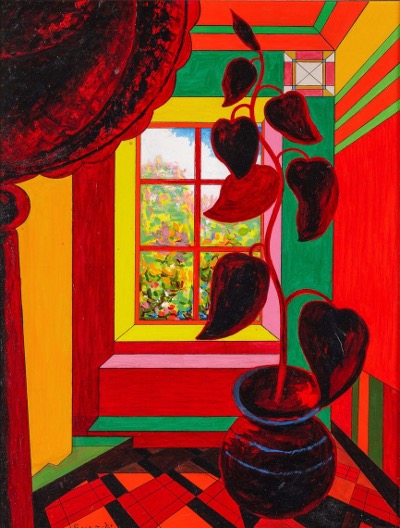Here we present a still life in which André Evard’s lyrical and constructivist styles intersect. From 1932 until his death, Evard dedicated equal space in his oeuvre to his figurative landscapes (show figurative landscape), still lifes (show still life), and concrete-abstract representations (show abstract composition).
This work can be divided into two pictorial planes. On the one hand, we have a colorful floral world in front of the window, entirely in the style of his lyrical landscapes. On the other hand, we have the interior space composed of geometric forms, which is interrupted by the potted plant and the curtain on the left side of the image.
Round, organic outlines in the plant and the curtain, as well as straight lines and geometric forms, are positioned here in stark contrast. The viewer is disoriented, as on the one hand, the geometric background predominates in quantity, and on the other hand, the main motif, an organic plant, has been placed in the foreground.
The curtain, in its composition, distantly recalls the series “Symphonia”, while the plant, in its form, bears Fauvist characteristics. It is the counterpart to the curtain and serves a superficial balance of the pictorial elements, which, however, is destabilized by the dissolution of perspective.
On the right side, the use of diagonals feigns a central perspective, whose vanishing point should lie within the window. In reality, however, it becomes clear that the painting has no vanishing point – i.e., a point where all lines converge – and thus no central perspective is present. This contradiction and the right-aligned positioning of the plant introduce unrest into the image. The viewer no longer knows where to direct their gaze.
Another element contributing to the viewer’s confusion are the shadows of the potted plant and the window ledge. According to the incidence of light from the window, the shadow should actually extend more steeply backward. Furthermore, the shadow of the plinth in the left half of the image should not exist in this manner.
These contradictions are deliberately employed by Evard, whether to harmoniously balance the black color fields on both halves of the image, or to rhythmize the painting with black rectangles and introduce movement into the image.
This tension between harmony and unrest, between organic and geometric, between interior and exterior, could indicate the tension between Evard’s two styles that converge here.
